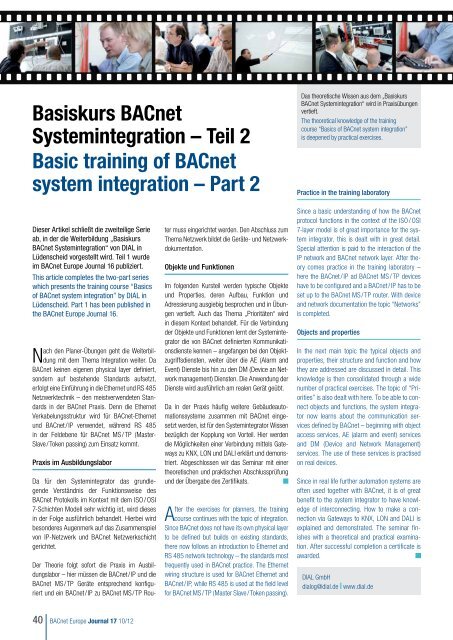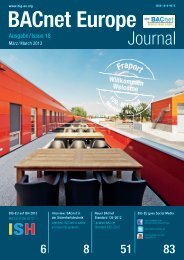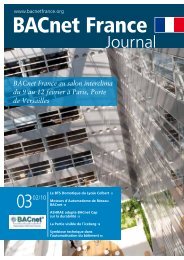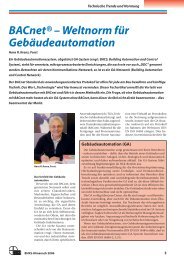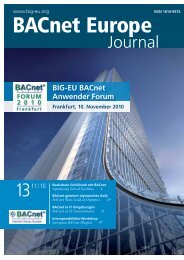BACnet Europe
BACnet Europe
BACnet Europe
You also want an ePaper? Increase the reach of your titles
YUMPU automatically turns print PDFs into web optimized ePapers that Google loves.
Basiskurs<strong>BACnet</strong><br />
Systemintegration–Teil2<br />
Basictrainingof<strong>BACnet</strong>systemintegration–Part2<br />
Dieser Artikel schließt die zweiteilige Serie<br />
ab, in der die Weiterbildung „Basiskurs<br />
<strong>BACnet</strong> Systemintegration“ von DIAL in<br />
Lüdenscheid vorgestellt wird. Teil 1 wurde<br />
im <strong>BACnet</strong> <strong>Europe</strong> Journal 16 publiziert.<br />
This article completes the two-part series<br />
which presents the training course “Basics<br />
of <strong>BACnet</strong> system integration” by DIAL in<br />
Lüdenscheid. Part 1 has been published in<br />
the <strong>BACnet</strong> <strong>Europe</strong> Journal 16.<br />
Nach den Planer-Übungen geht die Weiterbildung<br />
mit dem Thema Integration weiter. Da<br />
<strong>BACnet</strong> keinen eigenen physical layer definiert,<br />
sondern auf bestehende Standards aufsetzt,<br />
erfolgt eine Einführung in die Ethernet und RS 485<br />
Netzwerktechnik – den meistverwendeten Standards<br />
in der <strong>BACnet</strong> Praxis. Denn die Ethernet<br />
Verkabelungsstruktur wird für <strong>BACnet</strong>-Ethernet<br />
und <strong>BACnet</strong> / IP verwendet, während RS 485<br />
in der Feldebene für <strong>BACnet</strong> MS / TP (Master-<br />
Slave / Token passing) zum Einsatz kommt.<br />
Praxis im Ausbildungslabor<br />
Da für den Systemintegrator das grundlegende<br />
Verständnis der Funktionsweise des<br />
<strong>BACnet</strong> Protokolls im Kontext mit dem ISO / OSI<br />
7-Schichten Modell sehr wichtig ist, wird dieses<br />
in der Folge ausführlich behandelt. Hierbei wird<br />
besonderes Augenmerk auf das Zusammenspiel<br />
von IP-Netzwerk und <strong>BACnet</strong> Netzwerkschicht<br />
gerichtet.<br />
Der Theorie folgt sofort die Praxis im Ausbildungslabor<br />
– hier müssen die <strong>BACnet</strong> / IP und die<br />
<strong>BACnet</strong> MS / TP Geräte entsprechend konfiguriert<br />
und ein <strong>BACnet</strong> / IP zu <strong>BACnet</strong> MS / TP Rou-<br />
40<br />
<strong>BACnet</strong> <strong>Europe</strong> Journal1710/12<br />
ter muss eingerichtet werden. Den Abschluss zum<br />
Thema Netzwerk bildet die Geräte- und Netzwerkdokumentation.<br />
Objekte und Funktionen<br />
Im folgenden Kursteil werden typische Objekte<br />
und Properties, deren Aufbau, Funktion und<br />
Adressierung ausgiebig besprochen und in Übungen<br />
vertieft. Auch das Thema „Prioritäten“ wird<br />
in diesem Kontext behandelt. Für die Verbindung<br />
der Objekte und Funktionen lernt der Systemintegrator<br />
die von <strong>BACnet</strong> definierten Kommunikationsdienste<br />
kennen – angefangen bei den Objektzugriffsdiensten,<br />
weiter über die AE (Alarm and<br />
Event) Dienste bis hin zu den DM (Device an Network<br />
management) Diensten. Die Anwendung der<br />
Dienste wird ausführlich am realen Gerät geübt.<br />
Da in der Praxis häufig weitere Gebäudeautomationssysteme<br />
zusammen mit <strong>BACnet</strong> eingesetzt<br />
werden, ist für den Systemintegrator Wissen<br />
bezüglich der Kopplung von Vorteil. Hier werden<br />
die Möglichkeiten einer Verbindung mittels Gateways<br />
zu KNX, LON und DALI erklärt und demonstriert.<br />
Abgeschlossen wir das Seminar mit einer<br />
theoretischen und praktischen Abschlussprüfung<br />
und der Übergabe des Zertifikats.<br />
After the exercises for planners, the training<br />
course continues with the topic of integration.<br />
Since <strong>BACnet</strong> does not have its own physical layer<br />
to be defined but builds on existing standards,<br />
there now follows an introduction to Ethernet and<br />
RS 485 network technology – the standards most<br />
frequently used in <strong>BACnet</strong> practice. The Ethernet<br />
wiring structure is used for <strong>BACnet</strong> Ethernet and<br />
<strong>BACnet</strong> / IP, while RS 485 is used at the field level<br />
for <strong>BACnet</strong> MS / TP (Master Slave / Token passing).<br />
Das theoretische Wissen aus dem „Basiskurs<br />
<strong>BACnet</strong> Systemintegration“ wird in Praxisübungen<br />
vertieft.<br />
The theoretical knowledge of the training<br />
course “Basics of <strong>BACnet</strong> system integration”<br />
is deepened by practical exercises.<br />
Practice in the training laboratory<br />
Since a basic understanding of how the <strong>BACnet</strong><br />
protocol functions in the context of the ISO / OSI<br />
7-layer model is of great importance for the system<br />
integrator, this is dealt with in great detail.<br />
Special attention is paid to the interaction of the<br />
IP network and <strong>BACnet</strong> network layer. After theory<br />
comes practice in the training laboratory –<br />
here the <strong>BACnet</strong> / IP ad <strong>BACnet</strong> MS / TP devices<br />
have to be configured and a <strong>BACnet</strong> / IP has to be<br />
set up to the <strong>BACnet</strong> MS / TP router. With device<br />
and network documentation the topic “Networks”<br />
is completed.<br />
Objects and properties<br />
In the next main topic the typical objects and<br />
properties, their structure and function and how<br />
they are addressed are discussed in detail. This<br />
knowledge is then consolidated through a wide<br />
number of practical exercises. The topic of “Priorities”<br />
is also dealt with here. To be able to connect<br />
objects and functions, the system integrator<br />
now learns about the communication services<br />
defined by <strong>BACnet</strong> – beginning with object<br />
access services, AE (alarm and event) services<br />
and DM (Device and Network Management)<br />
services. The use of these services is practised<br />
on real devices.<br />
Since in real life further automation systems are<br />
often used together with <strong>BACnet</strong>, it is of great<br />
benefit to the system integrator to have knowledge<br />
of interconnecting. How to make a connection<br />
via Gateways to KNX, LON and DALI is<br />
explained and demonstrated. The seminar finishes<br />
with a theoretical and practical examination.<br />
After successful completion a certificate is<br />
awarded.<br />
DIAL GmbH<br />
dialog@dial.de | www.dial.de


